8.4 Configuring Virtual Search Servers
After you have created a virtual search server, you can fine-tune it by modifying many of its default settings. This section describes how to configure an individual virtual search server.
HINT:When you create a new virtual search server, all of its default settings are inherited from the Global Settings pages of QuickFinder. If you are the global administrator, you can modify these settings so that when you create a new virtual search server, its default settings reflect your preferences. (See Section 7.1, Differences between Default and Services Settings.)
8.4.1 Configuring General Settings
The General Settings page of QuickFinder Server Manager lets you configure the way that the virtual search server handles requests from clients for search services. You can modify general search query, search response, error log, and e-mail settings (if the global administrator has enabled the e-mail feature).
Modifying General Search Query Settings
-
On the Global Settings page of QuickFinder Server Manager, click in the row of the virtual search server that you want to work with.
-
Click under .
-
From the drop-down list, select an encoding that represents the character set encoding that the users of your search services are most likely to use.
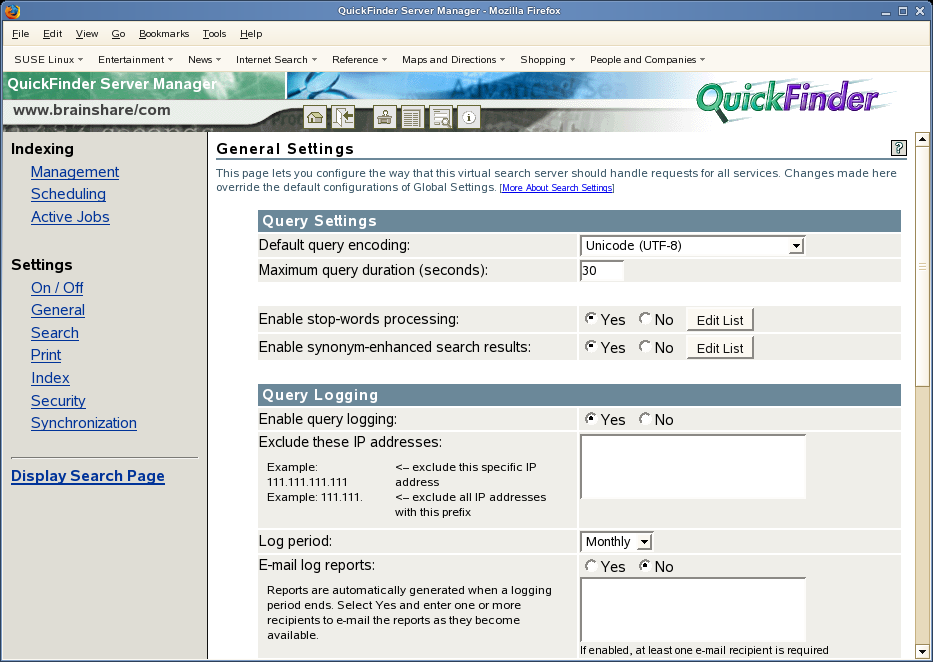
For more information about character sets, see Section B.0, Combined Character Sets for Use with QuickFinder.
-
In the field, specify the maximum number of seconds before QuickFinder should end a query, regardless of whether a search has been completed.
This option is one of several methods for letting you protect your server’s resources from processing potential rogue searches, which are sometimes intended to harm your service by consuming server resources.
-
(Optional) Click next to if you want QuickFinder to ignore insignificant words, such as adverbs, conjunctions, or prepositions, in a user’s search query.
For information about how to modify the list of stop-words used by QuickFinder, see Editing the Stop-Words List.
-
(Optional) Click next to if you want QuickFinder to expand search queries by looking for synonyms of the original search terms.
Synonym enhancement is not performed within the FileFilter section of a search. For more information about synonym enhanced searches, see Using Synonyms to Broaden Search Results.
-
Click .
Modifying Query Logging Settings
When query logging is enabled, it captures many details about user queries, including total number of searches performed (for the current logging period), top 100 search terms, load statistics, and the number of print jobs performed. It also provides information about queries that resulted in a “not found” error message. This information can be used to improve the performance of your search services, or to identify areas of your site that could be improved.
Query logging is enabled by default. However, it is optional and can be turned off.
-
On the Global Settings page of QuickFinder Server Manager, click in the row of the virtual search server that you want to work with.
-
Click under .
-
Click next to .
or
If Query Logging has been enabled, click to turn it off.
-
In the field, specify one or more IP addresses of the computers that you want excluded from the query log, separating each additional address by a space or hard return.
This feature enables you to eliminate query logging for searches originating within your organization. Keeping query log information gathered from customer queries separate from log information related to employees of your own company can help you identify issues that directly affect your customers.
-
From the drop-down list, select a log period of either or .
QuickFinder records search requests in the current log file until the end of the specified period. When QuickFinder switches to a new log file, a report for the old log file is automatically generated.
-
In the field, specify one or more e-mail addresses where you want copies of each new log report sent, separating each additional address by a space or hard return.
If this field does not appear, it is because you have disabled e-mail services on your QuickFinder Server. To re-enable e-mail services, go to the QuickFinder Global Settings page and click .
-
To view an existing log report, select one from the field, then click .
If there are no logs listed, you have not yet generated a log report. Click to create a report of the current (not yet completed) log period. Depending on the amount of information in the logs, this process could take anywhere from a few seconds up to several hours to complete. After a new report is generated, it appears in this field.
-
(Optional) If you want to specify a different logging template, specify the name of the template in the field.
-
Click .
Modifying General Response Settings
-
On the Global Settings page of QuickFinder Server Manager, click in the row of the virtual search server that you want to work with.
-
Click under .
-
Under , select an output encoding from the drop-down list.
This setting specifies the encoding QuickFinder should use when responding to user queries using the search and print results templates, and the error and response messages templates.
-
Specify the maximum number of queries in the field to cancel the processing of search results that might take a long time to complete.
-
Click .
Modifying Error Log Settings
-
On the Global Settings page of QuickFinder Server Manager, click in the row of the virtual search server that you want to work with.
-
Click under .
-
In the field, specify the maximum size (in bytes) that QuickFinder should allow the log file to grow to.
Depending on the number of visitors that your virtual search server hosts, log files can become large. This setting protects your system’s hard drive resources.
The number you specify here is divided evenly between two log files. For example, if you specify 30000, each log file allows up to 15000 bytes of logged data. This ensures that you always have at least 15000 bytes of logged synchronization data.
-
Click .
Modifying E-Mail Settings
If this section of the General Settings page is not visible, it is because the global administrator has disabled it. If you are the global administrator, you can enable this feature from the page. In the section, enable e-mail services, then specify an outgoing SMTP hostname, port number, user ID, and password. This makes the section appear on the General Settings page for a virtual search server. Follow the instructions below to enable or disable e-mail services and to specify recipients.
-
On the Global Settings page of QuickFinder Server Manager, click in the row of the virtual search server that you want to work with.
-
Click under .
-
(Optional) Click next to if you want QuickFinder to generate an e-mail message when errors occur during the generation (or regeneration) of your virtual search server’s indexes, or when your indexes are being synchronized with other QuickFinder servers.
-
(Optional) If you enabled e-mail services, type one or more e-mail addresses indicating where error messages should be sent.
If the global administrator has specified default e-mail recipients, they appear here. You can remove them, or simply add additional addresses. Separate addresses by using a space, comma, semicolon, or carriage return.
-
Click .
Editing the Stop-Words List
Sometimes users include irrelevant words in their search strings, such as the conjunctions and, to, and of. These are referred to as stop words. The Stop Words feature of QuickFinder removes all occurrences of stop words from the search string before performing a search, except in the following situations:
-
Stop words processing has been turned off.
-
You prepend the word with a plus (+) sign (for example, +the).
-
They are the only words in the query.
-
They occur within a phrase.
You can add or remove words from the Stop-Words list. QuickFinder Server uses this list to determine which words it ignores in a user’s search string. QuickFinder includes a predefined list of stop words, but you can edit or change these at any time.
-
On the Global Settings page of QuickFinder Server Manager, click in the row of the virtual search server that you want to work with.
-
Click under .
-
Click to save any changes you have made.
Clicking causes any unsaved changes to be lost.
-
Under Query Settings, click next to .
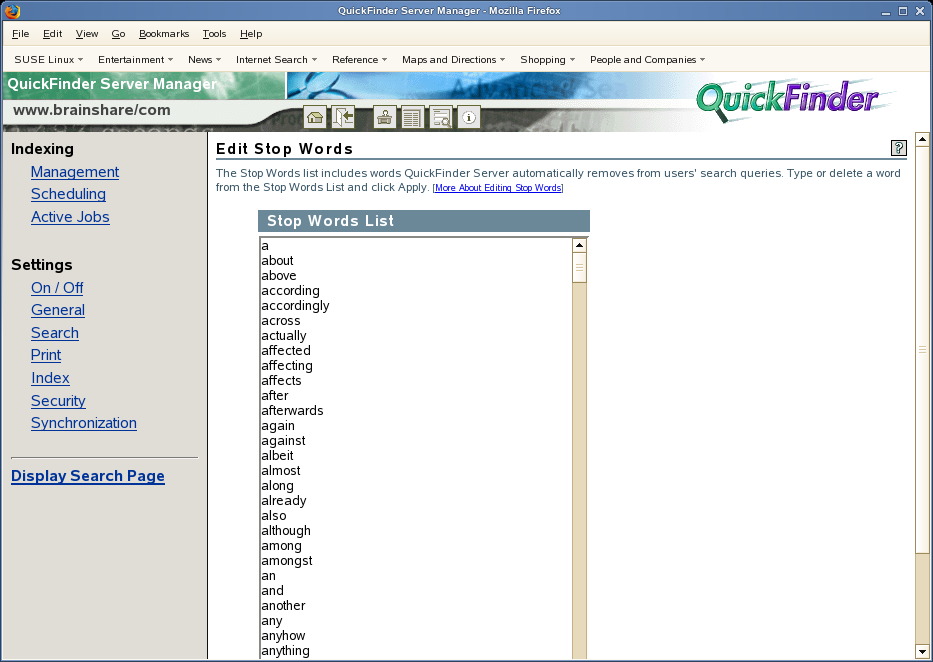
-
(Optional) To add a new word to the Stop-Words list, type a new word directly into the list.
Separate each new word with a space or a carriage return. When you click , the word is added to the list in alphabetical order, regardless of where you entered it in the list.
-
(Optional) To remove an existing stop word from the Stop-Words list, select it and press the Delete key.
To removing a stop word from the list, delete it from the global area.
-
Click .
For information about enabling and editing the synonym enhanced search settings, see Using Synonyms to Broaden Search Results.
8.4.2 Configuring Search Settings
The Search Settings page lets you configure the way that the virtual search server handles end user’s search queries. You can modify search query, search response, and template settings.
Modifying Search Query Settings
-
On the Global Settings page of QuickFinder Server Manager, click in the row of the virtual search server that you want to work with.
-
Under , click .
-
Under , click next to .
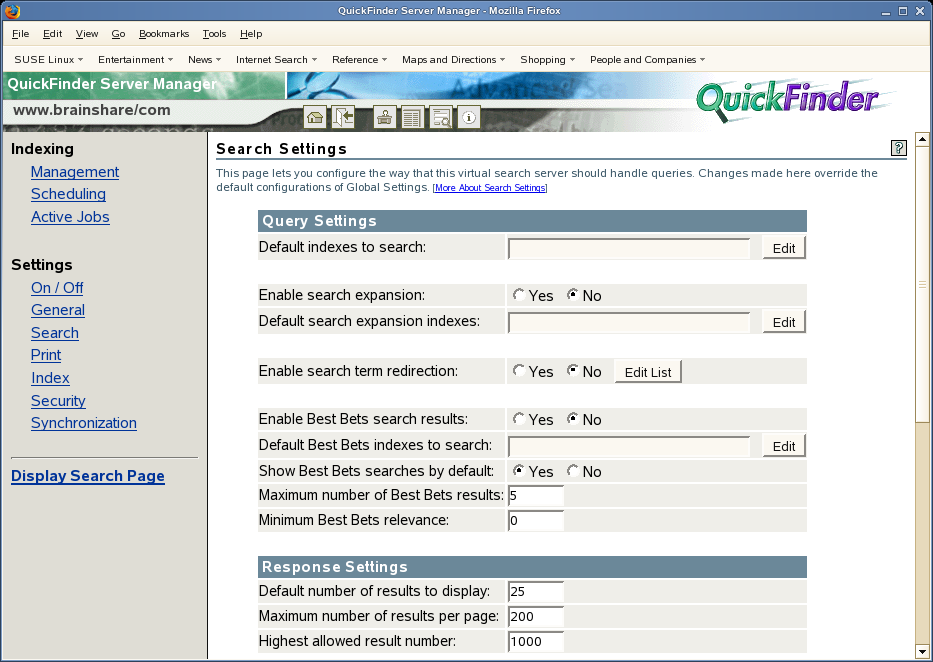
-
Select the indexes to be searched by default when a user does not select any indexes on the search form when performing a search, then click .
-
(Optional) Click next to if you want QuickFinder to automatically perform a second search using additional indexes when a first search query fails to find results.
For more information, see Section 10.6, Helping Users Avoid Failed Searches.
-
(Optional) If you enabled search expansion, click next to the field to select the indexes to be used during an expanded search, then click .
-
(Optional) Click next to if you want QuickFinder to redirect common search terms to a specific URL.
For more information, see Redirecting Searches.
-
Click to save any changes you have made.
Clicking causes any unsaved changes to be lost.
-
(Optional) If you enabled search term redirection, click to add common terms and their associated URLs, then click .
For more information, see Creating or Editing the Redirection URLs List.
-
(Optional) Click next to if you want QuickFinder to insert a secondary results list at the top of the search results page.
For more information, see Using Best Bets to Help Users Find the Right Information.
-
(Optional) Click next to the field and select the indexes for use with best bets.
-
(Optional) If you want the best bets results to always appear on the search results page, select next to .
Select if you want users to request the best bets results list at the time of their search request.
-
(Optional) In the field, type the maximum number of best bets results to be returned on each search results page.
-
(Optional) In the , type the number of low relevance documents you want removed from the best bets display list.
-
Click .
Modifying Search Response Settings
-
On the Global Settings page of QuickFinder Server Manager, click in the row of the virtual search server that you want to work with.
-
Under , click .
-
Under Response Settings, specify the number of search results in the field that you want displayed on each search results page.
For example, if you set this option to 25 (which is the default setting) and the number of hits in a return was 200, QuickFinder only returns 25 hits per search results page at a time.
-
Set a limit on the number of results allowed at one time on the results page by specifying a number in the field.
-
Specify the highest number of search results that can be returned to a user query in the field.
-
(Optional) Click next to to have QuickFinder provide alternate spelling suggestions for search terms.
-
Click to save any changes you have made.
Clicking causes any unsaved changes to be lost.
-
(Optional) Click to define your own words to ignore or misspelled words to replace.
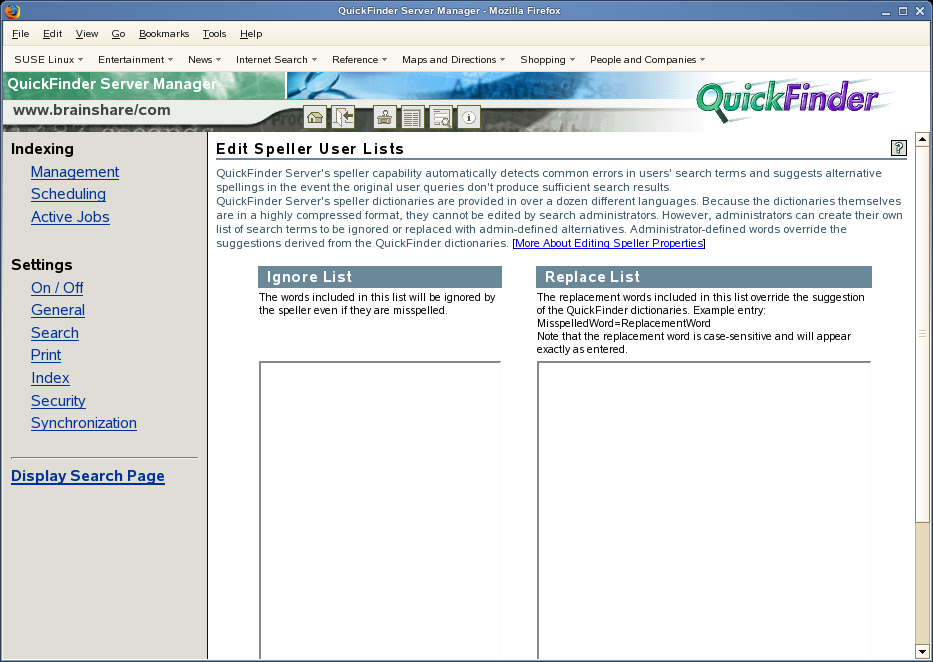
-
(Optional) Use the option to have QuickFinder spell-check search terms if the number of search results is lower than the number specified.
-
(Optional) Click next to if you want users’ search terms to be highlighted in the documents returned in a search.
-
Click to save any changes you have made.
Clicking causes any unsaved changes to be lost.
-
Click to modify the colors used by the Highlighter.
For information, see Selecting Highlighter Colors.
-
Click .
Modifying Template Settings
-
On the Global Settings page of QuickFinder Server Manager, click in the row of the virtual search server that you want to work with.
-
Under , click .
-
Under , specify a path to where your QuickFinder templates are stored in the field.
The default path is /var/lib/qfsearch/Templates. If you have created custom templates, or if you want to keep your templates elsewhere, specify the path here so that QuickFinder knows where the templates are.
-
From the drop-down list, select the character set that your templates are written in.
This value is used even with templates that do not specify an encoding. Encodings found in templates that do not match the encoding you specify here override this encoding.
-
In the field, specify the filename of the search page template you want to use.
If you have created a custom template and want QuickFinder to use it as your search page, specify its name in this field.
-
In the field, specify the filename of the search results template you want to use.
If you have created a custom search results template and want QuickFinder to use it as your default search results page, specify its name in this field.
-
In the field, specify the filename of the highlighter template you want to use.
If you have created a custom highlighter template and want QuickFinder to use it as your default search results page, specify its name in this field.
-
In the field, specify the filename of the template that QuickFinder should return if no results are found.
-
In the field, specify the filename of the template that QuickFinder should return if there are errors while processing a user’s query.
-
Click .
Selecting Highlighter Colors
Because a user can search for more than one search term at a time, you can define multiple colors so that each search term appears in a different color. For example, if a user searched for “HTTP AND Apache,” the terms appear highlighted in the documents where they originated.
The colors are used in the order in which they are defined. If only two highlight colors are defined but a user searches for three search terms, the first color is repeated.
-
On the Global Settings page of QuickFinder Server Manager, click in the row of the virtual search server that you want to work with.
-
Under , click .
-
On the Search Settings page, click under .
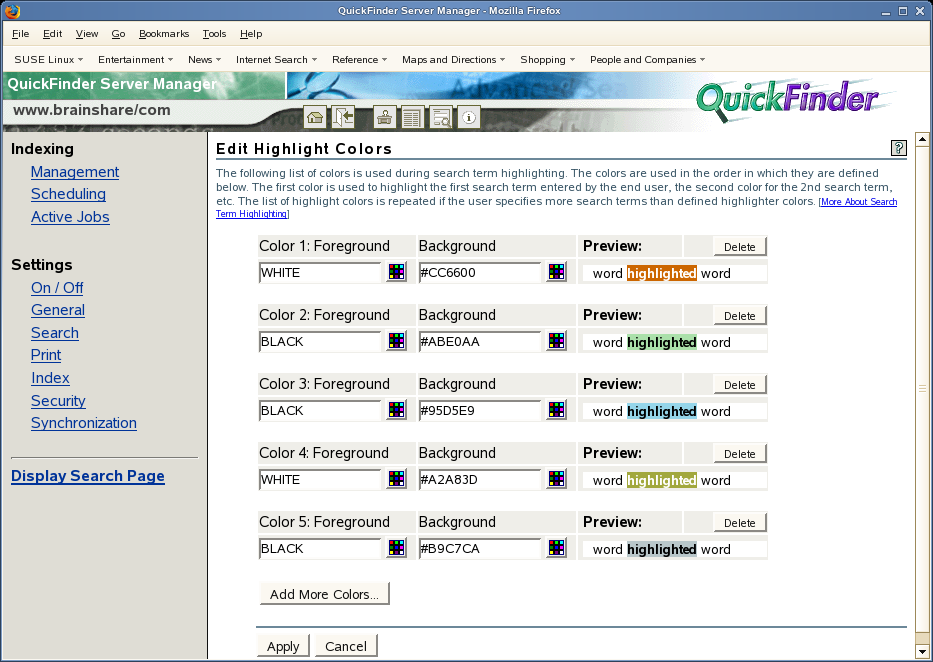
-
To define a new highlight color, click the button in the and columns to select a color.
You can also specify the color value (such as #RRGGBB) or color names.
-
To define additional color sets, click .
-
To remove a defined color set, click in the row of the color set you want removed.
-
Click .
8.4.3 Configuring Print Settings
The Print Settings page lets you configure the way that the current virtual search server handles end user’s print queries. You can modify print result and template settings.
Modifying Default Print Settings
-
On the Global Settings page of QuickFinder Server Manager, click in the row of the virtual search server that you want to work with.
-
Click under .
-
Under , specify the number of print results in the field that you want displayed on each print results page.
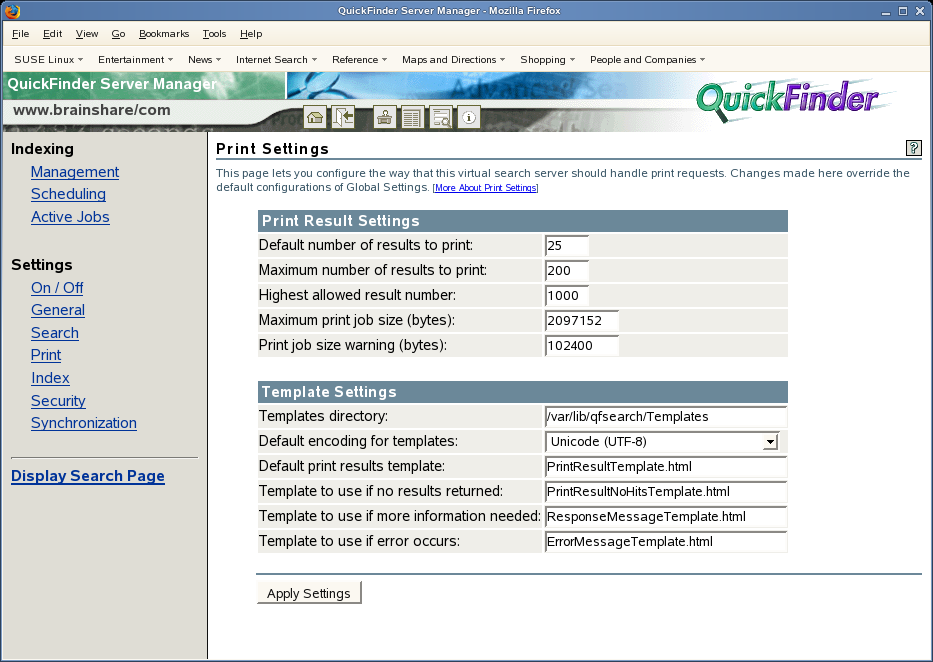
For example, if you set this to 25 (which is the default setting) and the number of hits in a return was 200, QuickFinder only returns 25 hits per print results page at a time.
-
Set a limit on the number of results allowed at one time on the results page by specifying a number in the field.
-
Specify the highest number of search results that can be returned to a user query in the field.
-
To limit the size of a print job, specify the largest print job size that QuickFinder will allow in the field.
Users requesting a print job larger than this value receive a message informing them that the request was too large.
This is a useful feature for administrators who want to keep down the size of print jobs in their own companies, departments, or organizations.
-
To be notified when a print job exceeds a certain size, specify the print job size in the field.
By default, this message is sent by using the ResponseMessageTemplate.html file and is intended as a warning to users that they are exceeding the allowed print job size. It then prompts the user to confirm the print job before continuing.
-
Click .
Modifying Default Print Template Settings
-
On the Global Settings page of QuickFinder Server Manager, click in the row of the virtual search server that you want to work with.
-
Click under .
-
Under , specify a path in the field to where your QuickFinder templates are stored.
The default path is /var/lib/qfsearch/Templates. If you have created custom templates, or want to keep your templates elsewhere, specify the path here so that QuickFinder knows where the templates are.
-
From the drop-down list, select the character set that your templates are written in.
This value is used even with templates that do not specify an encoding. Encodings found in templates that do not match the encoding you specify here override this encoding.
-
In the field, specify the filename of the print results template you want to use.
If you have created a custom print results template and want QuickFinder to use it when returning print results, specify its name in this field.
-
In the field, specify the filename of the template that QuickFinder should return if no print results match a user’s query.
-
In the field, specify the filename of the template to be sent back to users whose print jobs exceed the size you specify in the Print Job Size field. (See Step 6.)
-
In the field, specify the filename of the template that QuickFinder should return if there are errors while processing a user’s print query.
-
Click .
8.4.4 Configuring Index Settings
These settings are intended to make the process of creating indexes even easier by letting you configure common settings as default settings. This saves you time by not making you make the same selections each time you create a new index.
Modifying Default Index Settings
-
On the Global Settings page of QuickFinder Server Manager, click in the row of the virtual search server that you want to work with.
-
Click under .
-
Select the type of index that you want as the default index type on the page.
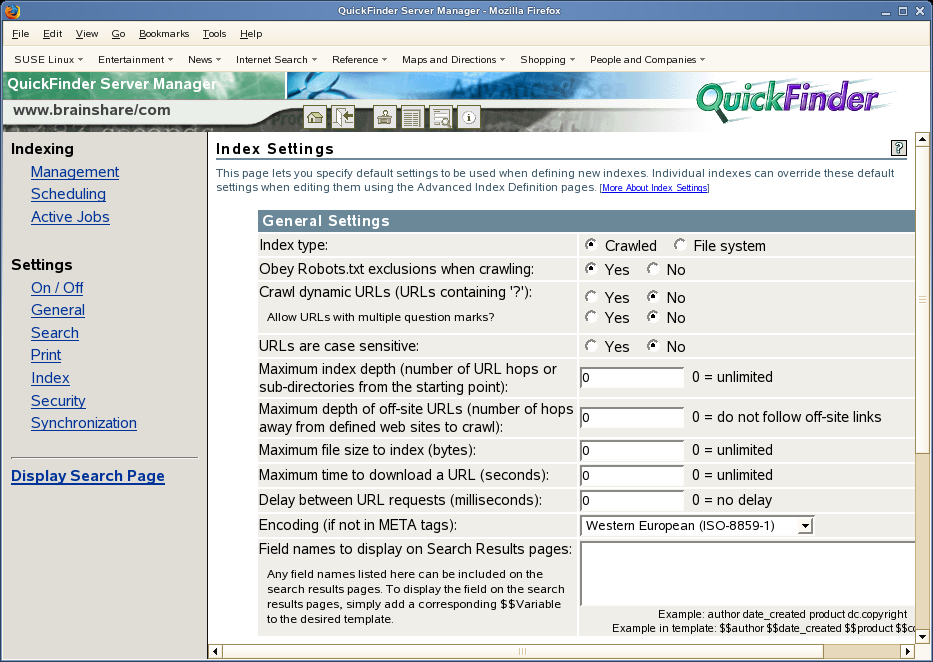
Each time you create a new index, the index type you select here is automatically selected. You can change the default index type when you create an index.
-
Click next to to instruct QuickFinder to obey the instructions in the Robots.txt file as it indexes Web sites.
For more information about Robots.txt, see Using the Robots Meta Tag.
-
Click next to if you want QuickFinder to index dynamic content, in addition to static content.
Some search engines do not crawl Web pages that are created dynamically, such as pages generated from forms submitted by a Web browser. The URLs of dynamic content typically contain a question mark (?) followed by additional parameters. (See Section 8.7, Indexing Dynamic Web Content.)
Because dynamic content can change at any time, you might want to schedule more frequent regeneration events for your indexes when enabling this feature. For information about scheduling automatic updates to your indexes, see Section 8.9, Automating Index and Server Maintenance.
-
Click next to if you want QuickFinder to crawl URLs with multiple query strings (parameters).
-
Select the option if you want QuickFinder to recognize URLs that are different only in character case, but are otherwise identical (for example, www.digitalairlines.com verses www.DigitalAirlines.com).
IMPORTANT:Setting this option to can help QuickFinder avoid indexing duplicate information, which can come from indexing URLs that are presented using different cases but actually point to the same information. However, if a Web server being indexed is configured to differentiate between cases, QuickFinder might leave out content that you want indexed.
-
In the field, specify the maximum number of hypertext links from the starting URL that QuickFinder should follow before it stops indexing.
-
In the field, specify the maximum number of hypertext links off-site from the starting URL that QuickFinder should follow before it stops indexing.
-
Specify a number (in bytes) in the field to keep QuickFinder from indexing files larger than the number you specify.
-
In the field, specify a number (in seconds) before QuickFinder automatically skips the indexing of the specified URL.
-
Type a number (in milliseconds) in the field that QuickFinder should pause between requests for URLs that it is trying to index.
-
From the drop-down list, select the encoding to be used when indexing files that do not contain an encoding specification.
For example, HTML files can specify their encoding with a Content-Type meta tag.
-
In the field, list any field names that you want to be included on the search results page (for example, author date_created product dc.copyright).
To display the field on the search results pages, add the corresponding $$Variable to the template (for example, $$author $$date_created $$product $$copyright).
The field data is stored in the index and causes the index size to increase.
-
Click .
Allowing Indexes to Be Used With QuickFinder Synchronization
-
On the Global Settings page of QuickFinder Server Manager, click in the row of the virtual search server that you want to work with.
-
Click under .
-
Under , click next to .
For more information about QuickFinder Synchronization, see Section 9.0, Synchronizing Data Across Multiple QuickFinder Servers.
-
Click .
Enabling or Disabling User Authentication When Accessing Indexes
-
On the Global Settings page of QuickFinder Server Manager, click in the row of the virtual search server that you want to work with.
-
Click under .
-
(Optional) Under , click to allow anyone to access the indexes.
No user authentication is required to search the indexes of the current virtual search server.
-
(Optional) Under , click to restrict access to the indexes only to those who have access rights to the filename you specify in the field.
-
In the field, specify the full path to a file on your server that already has rights protection assigned to it.
For example, if you are using Apache 2, you might type /usr/local/apache2/htdocs/index.html.
-
Select either or from the drop-down list to specify how QuickFinder should handle attempts to access indexes without authorization.
Select if you don’t want any search results displayed when users attempt to search the index without first logging in. A No Results Found message is returned instead.
Select to have QuickFinder return search results to users who have not logged in. When they attempt to click a search result, they are then prompted for a username and password.
HINT:You can use the $$BeginUnAuthorized and $$EndUnAuthorized template variables to control how the template should display unauthorized hits. For more information about template variables, see Section 12.0, Working with Template Variables and Search Parameters.
-
Click .
8.4.5 Configuring Security Settings
Security settings let you manage access to indexed content by requiring users to authenticate to a server before seeing rights-protected search results. The Security Settings page lets you configure rights-based search results and specify secure connection settings, including enabling the HTTPS protocol for securing usernames and passwords as they are sent over the network.
Modifying Default Rights-Based Search Results
-
On the Global Settings page of QuickFinder Server Manager, click in the row of the virtual search server that you want to work with.
-
Under , click .
-
In the box, type the Novell eDirectory context where user objects are stored.
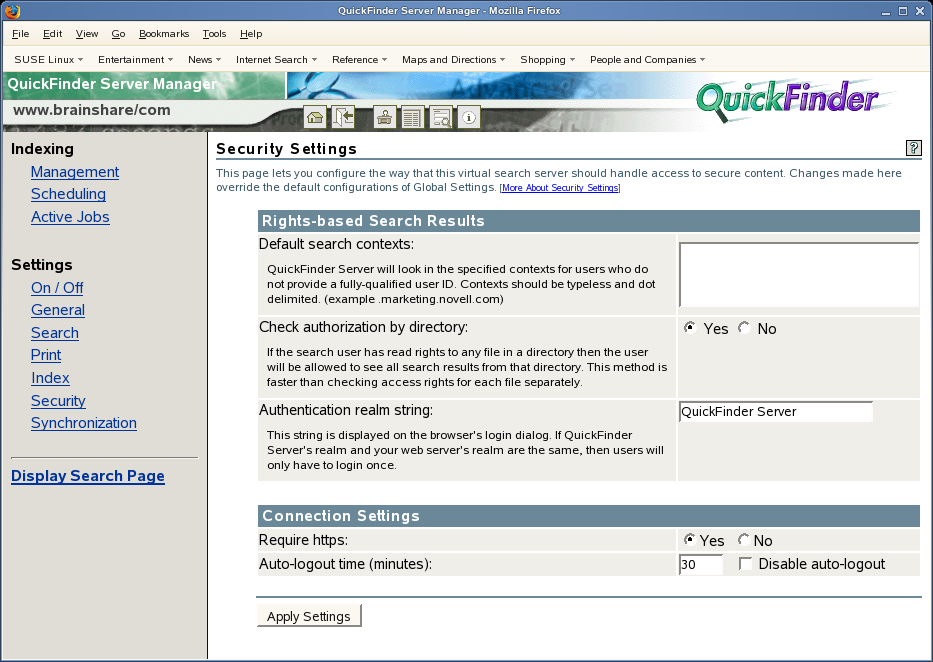
If you provide a context here, users won’t need to supply their fully qualified user IDs when logging in to QuickFinder. For example, if your user objects are all kept in a container named employees, type employees.marketing.digitalairlines in the box so that QuickFinder knows where to look when a user attempts to log in. A user whose fully qualified name is sjones.employees.marketing.digitalairlines only needs to enter sjones.
-
Click next to if you want QuickFinder to validate user rights to files in a directory (search results) based on whether or not users have rights to any one file in the same directory.
If a larger number of results are from the same directory, this can help to speed up the search.
-
(Optional) If you are using basic authentication (as apposed to using form-based authentication), then in the field, specify the correct authentication realm string, which is typically shown in your Web browser’s login dialog box.
Specifying the Apache Web server’s authentication realm string in this field means that after users authenticate to the Web server, they won’t need to authenticate again when using QuickFinder to search and access protected information.
If Apache is your Web server, refer to http://httpd.apache.org/docs-2.0/howto/auth.html for more information about authentication.
-
Click .
Modifying Default Connection Settings
-
On the Global Settings page of QuickFinder Server Manager, click in the row of the virtual search server that you want to work with.
-
Under , click .
-
Under , click next to if you want to protect usernames and passwords as they are sent across the network or Internet.
-
Specify a number (in minutes) in the field to direct QuickFinder to log users out who have been idle for the specified period of time.
-
Click .
8.4.6 Configuring Synchronization Settings
QuickFinder Synchronization lets you designate one QuickFinder server as the search master from which updated indexes, templates, and configuration settings are systematically sent out to all other QuickFinder servers defined as part of a QuickFinder Synchronization cluster.
For more information about setting up and configuring QuickFinder Synchronization, see Section 9.0, Synchronizing Data Across Multiple QuickFinder Servers.
-
On the Global Settings page of QuickFinder Server Manager, click in the row of the virtual search server that you want to work with.
-
Under , click .
-
Select next to .
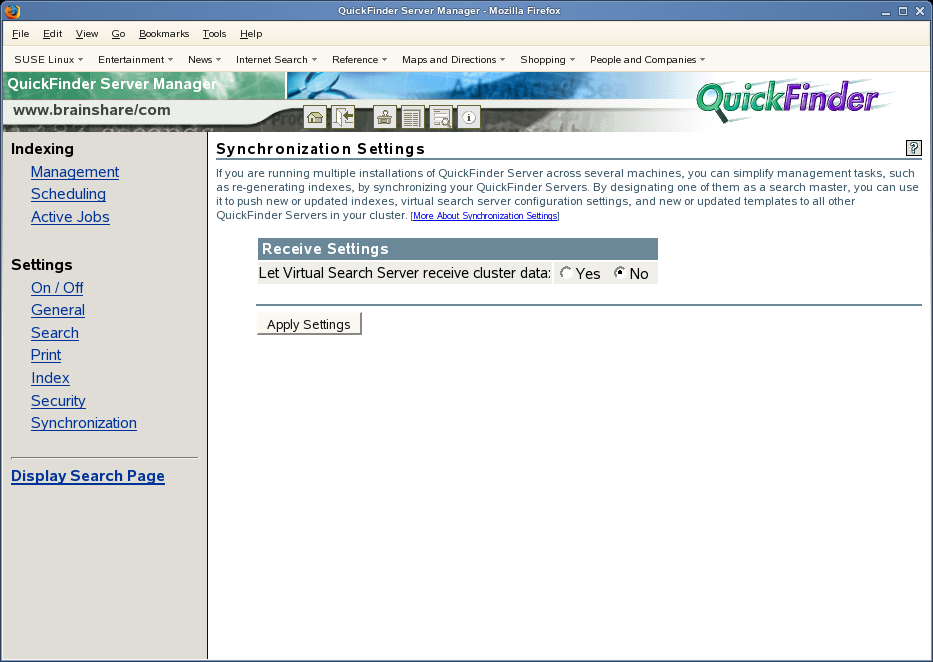
-
Click .